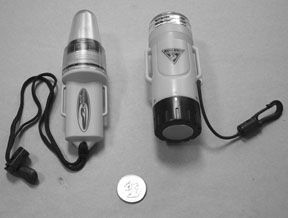
Every couple of years, PS gathers and tests personal strobe lights just to stay on top of the offerings in this important market niche. Not long ago, two new lights caught our attention when we went hunting for safety gear to take along on the 777-mile Charleston to Bermuda Race.
The HydroStar MultiStrobe, from Seattle Sports Co., is a unique animal in the realm of strobe lights because it’s designed and built to do triple duty as a strobe, a flashlight (with three power settings), or a set of navigation lights for a small vessel.
Built in China, the MultiStrobe is powered by four AAA batteries, with a claimed lifespan of 72 hours. The batteries power five combinations of the nine LED lights that sit within the unit’s dome. The base of the unit serves as the switch. It can be rotated from “off” to various settings depicted by symbols representing “strobe,” (120 times per minute) “nav,” or one of three flashlight settings.
To enchance its versatility, the HydroStar MultiStrobe is equipped with a short bungy lanyard and plastic clip, a metal clip for mounting on pockets, and has fixed slots in its body so that it can be lashed using webbing or hook-and-loop straps. It also has a magnet built into the bottom of the base, which mates with another magnet in a socketlike suction cup mount, included expressly for using the device as a nav light.
The interior circuitry seems well -built and the case and dome are rugged.
The HydroStar MultiStrobe is 4.25″ long (without the suction cup mount) weighs 8.4 oz., and retails for $29.95, including batteries. That might seem pricey for a small flashlight, but we think the price is reasonable given the product’s versatility, longevity, and that it carries a 1-year warranty. The only caveat here is that LED lights aren’t as bright as the zenon tubes ordinarily used in strobe lights, and thus aren’t likely to be seen at as great a distance.
Another light we took along with us is from Princeton Tec—the Aqua Strobe, which like the MultiStrobe, comes in an international orange plastic case. This strobe differs in that its sole function is as an emergency light, flashing up to 70 times per minute.
The Aqua Strobe’s zenon tube is powered by a single AA battery, which its manufacturers in Bordertown, NJ, say will run the light continously on for 8 hours.
Unique to the AquaStrobe is that it has no dedicated switch, but relies on the user to tighten the dome down sufficiently so that the reflector assembly (which houses the tube) comes into contact with the battery. You simply tighten the dome until the light begins to flash. To turn it off, back off the dome until it stops. In this position, the strobe is off, but the guts of the unit are still protected from water intrusion by the 0-ring seal. The Aqua Strobe also floats with its lens up. For storage, the manufacturer recommends removing the battery.
The Aqua Strobe weighs 3.4 oz., and is sold with a battery, a hook-and-loop strap and buckle, and a short nylon lanyard and spring-loaded cinch stop. The light carries a 90-day warranty, and retails for $29.95.
PS will include these two items in our next test of personal strobes. In the meantime, we judged the Aqua Strobe’s flash to be brighter than the MultiStrobe’s (the latter also lacks a reflector). And both units easily survived a five-hour dunking in fresh water.
Contacts
• Seattle Sports Co., 800/632-6163, www.seattlesportsco.com
• Princeton Tec, 609/298-9331, www.princetontec.com

































